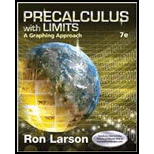
Concept explainers
(a)
To find: The mean, variance and standard deviation of the revised data.
(a)
Answer to Problem 38E
The explanation is given below.
Explanation of Solution
Given:
Multiply each number in exercise 28 by 3.
The data set of exercise 28 is given as:
The new data is given as:
The mean, variance and standard deviation of new data is calculated as:
Further simplified as:
The mean, variance and standard deviation of data of exercise 28 is calculated as:
Further simplified as:
Therefore, the mean, variance and standard deviation is increased after multiplying the data of exercise 28 by 3.
(b)
To find: The change in data of exercise 28 if each number is multiplied by a constant
(b)
Answer to Problem 38E
The explanation is given below.
Explanation of Solution
Case 1: If constant is greater than1.
Then after multiplying by the constant
Case 1: If constant is less than
Then after multiplying by the constant
Case 1: If constant is between
Then after multiplying by the constant
Therefore, the explanation is given above.
Chapter B Solutions
Precalculus with Limits: A Graphing Approach
 Calculus: Early TranscendentalsCalculusISBN:9781285741550Author:James StewartPublisher:Cengage Learning
Calculus: Early TranscendentalsCalculusISBN:9781285741550Author:James StewartPublisher:Cengage Learning Thomas' Calculus (14th Edition)CalculusISBN:9780134438986Author:Joel R. Hass, Christopher E. Heil, Maurice D. WeirPublisher:PEARSON
Thomas' Calculus (14th Edition)CalculusISBN:9780134438986Author:Joel R. Hass, Christopher E. Heil, Maurice D. WeirPublisher:PEARSON Calculus: Early Transcendentals (3rd Edition)CalculusISBN:9780134763644Author:William L. Briggs, Lyle Cochran, Bernard Gillett, Eric SchulzPublisher:PEARSON
Calculus: Early Transcendentals (3rd Edition)CalculusISBN:9780134763644Author:William L. Briggs, Lyle Cochran, Bernard Gillett, Eric SchulzPublisher:PEARSON Calculus: Early TranscendentalsCalculusISBN:9781319050740Author:Jon Rogawski, Colin Adams, Robert FranzosaPublisher:W. H. Freeman
Calculus: Early TranscendentalsCalculusISBN:9781319050740Author:Jon Rogawski, Colin Adams, Robert FranzosaPublisher:W. H. Freeman
 Calculus: Early Transcendental FunctionsCalculusISBN:9781337552516Author:Ron Larson, Bruce H. EdwardsPublisher:Cengage Learning
Calculus: Early Transcendental FunctionsCalculusISBN:9781337552516Author:Ron Larson, Bruce H. EdwardsPublisher:Cengage Learning





